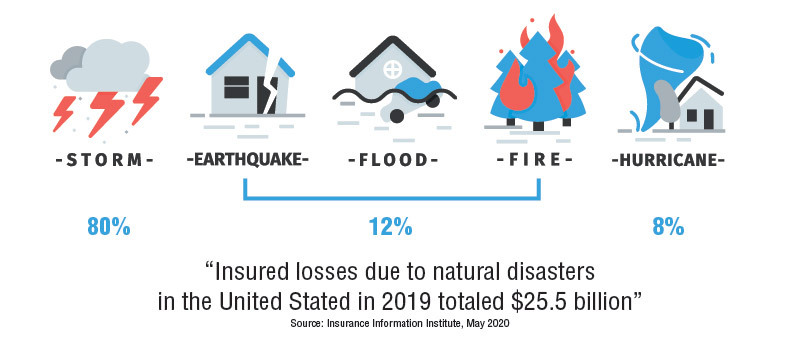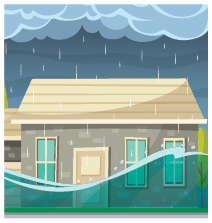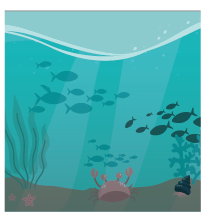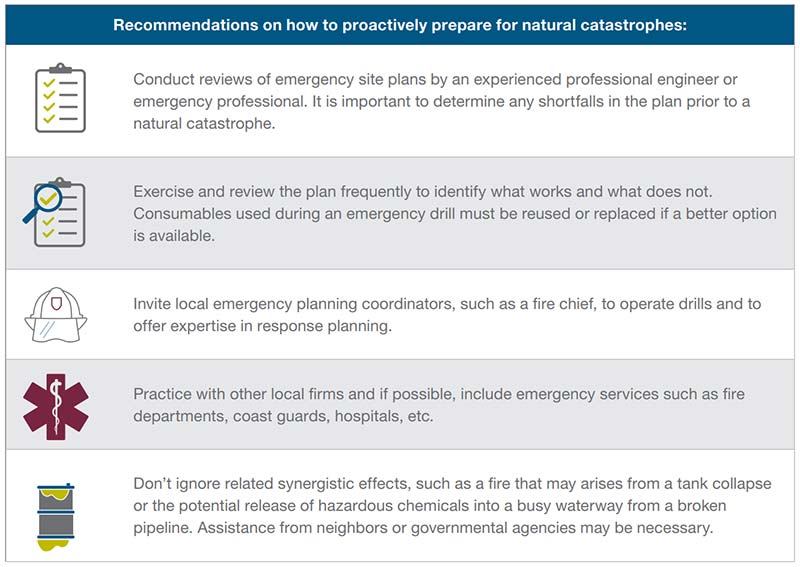Environmental Effects of Natural Catastrophes
Regardless of where you reside in the world, the likelihood of experiencing some degree of severe weather or a natural disaster is inevitable. Earthquakes, windstorms, tornadoes, hurricanes, wildfires and floods – all of which can cause immense damage to human-made structures and the natural environment – have the potential to generate long-term environmental harm, incurring cost and liability to property owners.

In very recent history, we have experienced an escalation of unexpected occurrences and in turn have reevaluated the importance of both awareness and preparation for unprecedented situations that may arise. When a natural disaster impacts a populated area, contamination is likely to follow. Environmental coverage becomes imperative when, for example, the run-off from flooding, ash from fires, or any other disaster-related contamination may pick up pollutants and have the potential to release them into the environment.
When a natural disaster does strike, you can count on Great American to deliver prompt communication, efficiency and professionalism to protect your clients from devastating financial loss related to environmental pollution.
Hurricanes
Hurricanes are one of nature’s most powerful storms. Generally known as a tropical cyclone, it gains energy from warm ocean waters bringing high winds, flooding, inundation and other issues to coastal and inland areas.

The greatest risk posed to human health as a result of a hurricane is flooding and inundation.

Severe flooding can significantly affect inland areas, often causing devastating injury and property damage.
.png?sfvrsn=88842b1_2)
Intense flooding can migrate soil and agricultural nutrients from fields into water ways which then seep into larger bodies of water such as dams, lakes, bays, and estuaries.

When introduced into bays and estuaries, the foreign agricultural nutrients may have deleterious effects on fish, shellfish, and other aquatic organisms. In many areas, the excess nutrients during floods creates nutrient-rich water allowing algae to flourish.
.png?sfvrsn=148842b1_2)
This spike in algae growth depletes oxygen in the water and creates ‘dead zones’ where fish and shellfish cannot survive, negatively impacting local watermen and tourist industries who greatly depend on aquatic life for income.
Hurricane flooding might also release pollutants such as mining fines, oil and grease-soaked sediments, metallic objects, nutrient-laden silt and polychlorinated biphenyls (PCBs) that were originally trapped in rivers and streams. Coupled with this, flooding often causes sewage lines and petroleum pipelines to fail which may release the piping contents into the flood waters. These pollutants often cause long-term environmental damage to receiving waters.1
Prior pollution disposal methods for industrial areas along the coast such as burial of “tank bottoms” may also pollute surrounding areas as wind-driven waves unearth the contaminants and deposit them into new sites. This can be substantially harmful to the surrounding fish and vegetation.
Hurricane flood waters also have the potential to cause damage to underground storage tanks (USTs). During rapid floods, UST systems can become submerged or displaced, leading to damaged tanks or even the releases of regulated substances into the environment. The displaced petroleum may migrate into the flood waters, eventually polluting the surrounding area.2

1972, Hurricane Agnes: Within a ten-day timeframe, Hurricane Agnes washed more pollutants into Chesapeake Bay than it had received within 25 years.3 The extensive amount of water introduced pollutants and lowered salinity levels, leading to a 100% mortality of oysters and 90% mortality of soft shell claims in some areas of the bay. Hurricane Agnes also reduced the amount of aquatic grasses in the bay which provided critical habitats to key species for spawning and improved water clarity.4

2005, Hurricane Katrina: During Hurricane Katrina, the Murphy Oil refinery was inundated with flood waters, damaging equipment and several onsite above ground storage tanks (ASTs), releasing over one million barrels of oil from the refinery and affecting as many as 10,000 homes in the surrounding neighborhoods.5
The released content, mostly diesel range oil, required extensive remediation to remove the spill from houses, roads, city canals and other urban community areas. In total, over 1,800 homes were coated with oil and the affected area was over one square mile.

2019, Hurricane Dorian: After the recent Hurricane Dorian, Equinor ASA responded to damage done to its Bahamas South Riding Point oil storage terminal. As a result of the hurricane’s high winds and wind-driven waves, five of the largest ASTs located at the terminal were severely damaged causing the release of massive amounts of oil. Unfortunately, Equinor did not have a sufficient onsite emergency plan in place and had to import response assets from Louisiana and Florida in order to effectively remediate the spill.6, 7
Equinor recently stated that they are quickly working to locate and remediate the escaped oil to avoid future releases in an event of another emerging storm.8
Windstorms & Tornadoes
During natural occurrences involving high winds, building foundations and equipment including storage tanks can be severally damaged. Common failures of tanks due to high-wind exposure includes9:
- Overturning or tipping tanks over
- Sliding or pushing tanks off foundations
- Buckling of tank walls
The higher the wind speed, the greater the pressure on a tank. ASTs should be equipped with both a primary and emergency vent. If the vents are not properly secured during a windstorm, suction may be generated and cause the roof of the tank to release liquids. Buckling of the tank walls can also prevent proper operations of the tank and potentially allow fugitive emissions to escape around the roof gaskets.
A common rule of thumb: a doubling of wind speed increases the wind pressure on the tank by its square.
The buoyancy of a tank is another risk factor to take into consideration during high winds. There must be sufficient ballast, usually a liquid product or water in the tank to keep it anchored onto the foundation and prevent floatation in the event of flooding. In certain areas of the United States, if the tank does not contain a sufficient amount of substance to prevent floating, the tank can be filled with water to avoid buoyancy.10
The amount of fluid in a tank can also prevent buckling by providing outward pressure which counteracts the force of the high winds. An important consideration for pre-storm planning is to contact a professional engineer to determine the standard amount of tank fluid necessary to prevent wind damage or tank failure. This information should then be noted in the site’s emergency response plan.
An unwritten rule to remember: At least three feet of liquid is required to avoid tank floatation.9
Also note that high winds can remove insulation from tanks that store heated fluids, requiring reinstallation in order to keep the tanks at proper temperature for processing.
Precautionary tank measures for windstorms or tornados may include:
- Determine minimum tank fill levels for anticipated wind grades.
- Identify available backup power and pumps to remove water from secondary containment areas.
- Reduce raw and processing materials from the site.
- Ensure that fire-fighting measures are adequate.
- Perform regular inspections – recommendations or repairs from an API 653 evaluations should be made expeditiously.
- Inspect for integrity and stability of secondary containment structures – necessary repairs should be made expeditiously.
Flooding
Floods are often unpredictable, and the aftereffects can be damaging and costly to mitigate. This type of disaster is caused by many different phenomena including natural processes such as heavy rains, snow melt, earthquakes, tsunamis or hurricanes.11
Flooding inundates large areas of the ground surface and can cause serious damage to the interior of buildings such as dry wall, carpets, flooring, furniture and electronics. If drying of building interiors is not completed quickly and thoroughly, mold can form which will require remediation. Due to the silt and mud in flood waters, it is common that inundation of carpets, furniture and equipment are often ruined and require complete disposal. However, after floods, disposal space is often at a premium, generating higher prices.
Any buried wastes in a stream bed or floodplain can be maneuvered by the flash flood waters and deposited downstream. A common problem that occurs includes contaminated sediments depositing in coastal wetlands, causing long-term environmental problems.12
Precautionary measures for flooding may include:
- Map the site and identification of low areas carefully as it is likely to experience inundation based on an engineering review
- Protect critical assets through the construction of dike and levees
- Identify government flood control assets and develop a monitoring plan for assets
- Determine escape routes and depending on water levels, when these escape routes can be safely used
- Confirm that the site is clean and hazardous materials are contained so any flood waters affecting the site do not become contaminated.
- Include flood preparation and response in the site’s emergency action plan
- Ensure that secondary containment areas are clean and free of fluids so maximum freeboard is available to contain any liquids in the secondary containment areas
Earthquakes
Earthquakes generate ground shaking, seismic waves, induced soil liquefaction, landslides, and transverse movement of the ground. Subsequently, this has the potential to damage physical structures such as ASTs, process equipment and various types of pipelines including oil, gas, water, and sewage. Damage to these may release hazardous materials into the environment.13, 14

The 1994 Northridge earthquake in Southern California for example, resulted in the failure of a buried pipeline and released 190,000 gallons of oil into the Santa Clara River. This mass release resulted in a fine of $7.1 million dollars, requiring the replacement of nearly 150 acres of river bottom.
Typically pipelines withstand ground shaking with few releases. However, when the earth experiences intense lateral and vertical movements, pipelines are more prone to failure and the substance within may be released. It is crucial to strategically route pipelines to avoid areas where extensive ground movement is likely to occur during unexpected earthquakes.
In addition to careful route selection, a thorough review by geologists and civil engineers is warranted. The estimated ground movement should be noted, and the pipeline’s material and other design features should be evaluated to ensure reasonable ‘earthquake resistances’ are set in place.
Precautionary measures for earthquakes may include:
- Determine maximum probable ground acceleration or shaking and conduct an engineering review for building construction, tanks structure and foundations to evaluate and ensure that critical assets can reasonably withstand the probably ground movement
- Segregate incompatible materials in case of container failure so no adverse reactions occur between spilled materials
- Ensure emergency generators are present and exercised regularly in case the facility needs power to store materials
- Develop emergency site plans which identify local facilities that may be adversely affected by an earthquake and what protective response equipment should be stocked onsite
Wildfires
A wildfire is an unplanned fire that burns in a natural area such as a forest, grassland or prairie. Human-made or natural, wildfires are subject to local and regional weather patterns and can generate its own wind, increasing the speed and unpredictability with which these fires spread. These factors and more can intensify the dangers posed by wildfires.

The primary effect of wildfires is the burning of buildings, infrastructure (power lines, roads, etc.), coupled with significant degradation of air quality and injury to humans.
Secondary effects include runoff, flooding, erosion and debris flows. After a wildfire, rainfall can greatly increase runoff from an area and transport large amounts of soil and silt into receiving bodies of water. This increased silt negatively affects aquatic organisms and fish habitats.
Wildfires can destruct native vegetation and often result in non-native weed species overtaking an area. This can present negative effects if the native vegetation of an area was important economically or supported other animals and vegetation.15

Removal of native vegetation also can reduce the slope stability of an area.
With the vegetation removed, soils are exposed to rainfall and no bonding effect of the vegetation roots are present.
Strong rains can infiltrate soil layers with water, which can create sliding or slipping layers which decreases the slope stability of a burned area.15
Due to the interruption of infrastructures, wildfires can affect the provision of necessary services such as:
An emergency watch should be instituted in times of known or suspected wildfires, so that when a warning occurs the facility can be shut down and evacuated quickly.16
Precautionary measures for wildfires may include17:
- Sign up for your community’s warning system: The Emergency Alert System (EAS), National Oceanic and Atmospheric Administration (NOAA), and the weather radio also provides emergency alerts.
- Be aware of your community’s evacuation plans and prepare the evacuation routes by finding sheltered locations; incorporate a plan for pets and livestock as well.
- Gather emergency supplies, including N95 masks. Keep in mind specific needs of each person, including an updated asthma action plan and medication.
- Designate a room that can be closed off from outside air. Set up a portable air cleaner to keep indoor pollution levels low when smoky conditions exist.
- Keep important documents in a fireproof, safe place and create password-protected digital copies.
- Use fire-resistant materials to build, renovate or make repairs.
- Find an outdoor water source with a hose that can reach any area of your property.
- Create a fire-resistant zone that is free of leaves, debris, or flammable materials for at least 30 feet from your home.
- Review your property insurance coverage.
- Pay attention to air quality alerts
Emergency Planning for Natural Catastrophes
The potential for natural catastrophes should be incorporated in a facility’s emergency planning. If a facility does not currently have a plan in place, Local Emergency Planning Committees (LEPCs) are required to develop threat maps in response to significant hazards within the area as well as provide information about chemicals in the community to citizens. These established LEPCs threat maps are easily accessible and can be used as a reference during preparation.
While creating an emergency plan for natural catastrophes, the history of the area should be investigated using records from United States Geological Survey (USGS) and National Oceanic and Atmospheric Administration (NOAA) to detect prior earthquakes, floods and fires. It is important to determine likely hazards for the area in order to include adequate planning for response and property recovery.

Interested in learning how environmental insurance can help mitigate loss caused by natural disasters?
Great American offers environmental insurance to help mitigate the risks described above. Contact your underwriter today to learn more about how our core products and services can help you protect your clients' operations in the event of a natural disaster!
References:
- Pollution by Sediments; Control of water pollution from agriculture - FAO irrigation and drainage paper 55, Edwin D. Ongley, United Nations; https://www.fao.org/4/w2598e/w2598e00.htm#Contents
- Underground Storage Tank Flood Guide; USEPA; November 2010 https://www.epa.gov/ust/underground-storage-tank-flood-guide
- Retrospective: The Damage Caused by Hurricane Agnes; June 19, 2019; The Washingtonian. https://www.washingtonian.com/2012/06/19/deluge/
- The Effect of Tropical Storm Agnes on he Chesapeake Bay Estuarine System, The Chesapeake Research Consortium, Inc; November 1976
- The Katrina Oil Spill Disaster: A Harbinger for the Atlantic Coast? The Louisiana Weekly; https://www.louisianaweekly.com/the-katrina-oil-spill-disaster-a-harbinger-for-the-atlantic-coast/
- Equinor Works to Clean Up Oil Spill at Bahamas Terminal; Rig Zone, 2019 https://www.rigzone.com/news/equinor_works_to_clean_up_oil_spill_at_bahamas_terminal-10-sep-2019-159763-article/
- Equinor: We will Clean Up the Bahamas Oil Spill; Equinor Web Site: https://www.equinor.com/en/news/equinor-bahamas.html
- Hurricane Dorian Oil Spill in Bahamas Has Spread to the Sea; Gizmodo – Environmental Justice; https://gizmodo.com/hurricane-dorian-oil-spill-in-bahamas-has-spread-to-the-1838042657
- Prepare Your Petroleum Storage Tanks for Hurricanes Phil Myers, PEMY Consulting; June 2018; https://www.bicmagazine.com/departments/maintenance-reliability/june-july-2018-nistm-tank-spotlight/
- Performance of Storage Tanks in Oil Facilities Following Hurricanes Katrina and Rita; Journal of Performance of Constructed Facilities; December 2007
- Underground Storage Tank Flood Guide; USEPA; November 2010 https://www.epa.gov/ust/underground-storage-tank-flood-guide
- Pollution by Sediments; Control of water pollution from agriculture - FAO irrigation and drainage paper 55, Edwin D. Ongley, United Nations; https://www.fao.org/4/w2598e/w2598e00.htm#Contents
- Earthquakes and Pipelines, Delaware River Keeper Network;
- Buckling and Rupture Failures of Pipeline Due to Large Ground Deformations; Teoman Ariman, University of Tulsa; 1971
- Emergency Pose-Fire Rehabilitation Treatment Effects pm Burned Area Ecology and Long-term Restoration; Springer Link; https://link.springer.com/article/10.4996/fireecology.0501115
- Hurricane Dorian Oil Spill in Bahamas Has Spread to the Sea; Gizmodo – Environmental Justice; https://gizmodo.com/hurricane-dorian-oil-spill-in-bahamas-has-spread-to-the-1838042657
- Wildfires; Ready.gov; https://www.ready.gov/wildfires